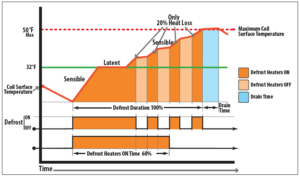Over the last few decades, we have witnessed monumental changes in the world of technology and how it affects our everyday life. Email, texting and social networks have drastically changed the way we communicate with each other. Business happens 24 / 7 in the wired world.
One industry that has not kept pace is commercial refrigeration. With all of the potential benefits available, we still utilize decades old technology in operating and servicing refrigeration equipment.
Let’s jump right into a problem encountered at a real installation experienced in a quick service restaurant (QSR) and take a look at the advantages of using some of today’s technology to effectively, and quickly, diagnose and service the system.
Common problem
Figure 1 and Figure 2 show a common refrigeration problem: excessive frost and ice on both product packages and walk-in surfaces. This restaurant location had a recurrent ice problem for the past few years. The presence of a plastic curtain in the doorway, and numerous defrost set-ups, were not able to overcome the formation of ice in the walk-in freezer.
Figure 1: Frost and ice on surfaces.
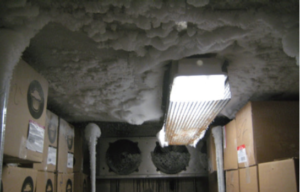
Figure 2 Icy evaporator
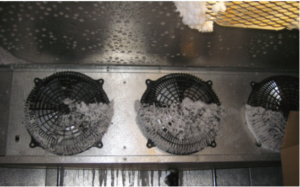
The normal reaction of the refrigeration technician is to increase the number of defrost cycles on the defrost time clock. While the situation improves temporarily, the problem comes back after a while. In the present case, even 4 cycles of 45 minutes per day was not enough to clear up the problem.
I imagine you are now debating on causes, and speculating on what should be done to correct the problem. Let’s work through this together.
Potential causes – analyzing the situation
- We check the drain and see it is not plugged.
- The defrost termination and fan delay sensors are properly installed and functional.
- Rotation of evaporator fans is appropriate.
- To control humidity infiltration, a good plastic strip curtain is installed (instead of a door switch to control evaporator fans.)
- There is a dishwasher 12 feet from the freezer door.
- The walk-in temperature set point is at -5°F.
More subtle causes – further analysis
- Lack of silicone in the panel joints can accelerate the humidity transfer. Verification with the walk-in manufacturer certifies that no joint is required since a continuous metal sheet is used behind the interior panels. Indeed, the inside joints are not showing more ice than the other surfaces.
- The freezer door is frequently opened by staff into a hot kitchen. Strip curtains minimize the impact of this activity.
- The use of the remote dishwasher is also a factor in the high humidity level, although the plastic curtain reduces the effect.
- Bakery goods and products are mainly stored in cardboard boxes or open plastic bins. The high demand exposes the products to ambient air, therefore, we believe that water migration from product to evaporator surface was done by sublimation.
Solution
After review of all of the possible causes for the recurring problems, the replacement of the conventional defrost timer by an intelligent demand defrost/evaporator efficiency controller was proposed by the service contractor, and accepted by the customer. Since we have no control over the door opening rate, humidity level, inventory level and product sublimation, the controller would be in a position to better decide when defrost was needed.
The controller manages the evaporator fans, electric defrost heaters and liquid line solenoid valve. It also controls the room setpoint and determines the appropriate time for defrost, only when the coil heat transfer capability is reduced more than 10%.
As frost is accumulated on the evaporator coil, the controller will utilize the frost to assist in managing the refrigeration load. Instead of activating the defrost heaters to melt the frost; the controller will manage the evaporator fans to sublimate the
frost. In other words, defrost occurs without adding heat by the defrost heaters. Since the customer already paid to solidify water vapor on the coil, when possible the intelligent controller will use this frost to maintain room temperature without cycling the compressor.
In addition, a defrost temperature sensor installed in the evaporator, instead of a metal sensor installed on the evaporator U bend, will provide more accurate readings to better manage the defrost heaters and help prevent instantaneous vaporization (fogging) of melting frost during the defrost mode.
Figure 3 shows an interrupted sequence of electric defrost heaters when the measured temperature by the temperature sensor is above latent point. A steeper curve of temperature could signify a partial or total absence of the frost on the evaporator surfaces. There is no need to energize the defrost heaters permanently. Figure 1 shows water vapor that can potentially solidify on colder surfaces, like fan guards and walk-in panels.
Also, the blue zone on Figure 3 shows a drain cycle that doesn’t exist when using a traditional defrost timer. But, what is the use of starting the refrigeration cycle if there are still water droplets between the evaporator fins that will quickly freeze, requiring another defrost sooner?
Now that we have the intelligent evaporator efficiency controller operational to alleviate the recurring problems of the system, we can utilize the on board communications technology to confirm if our solution is getting the job done.
Figure 3 – On-Off cycles of defrost resistances
Simple remote communication – the other piece to the solution
Refrigeration systems controlled by thermostats and time clocks do not offer visibility for the service technician to view the operation of the system. More sophisticated controllers, that do offer a communications solution, often require special programming, detailed set up and monthly maintenance fees. This is time consuming and costly to the end user.
The communication protocol TCP/IP is largely used to view webpage applications. In short, when you type Google.com in a web browser window such as Chrome, Explorer or Firefox, the page that opens does not require any software installation or detailed set up. The controller described in the present project uses this simple Ethernet based communication. Let’s take a deeper look at this type of hardware and software and the benefits for the service technician.
Hardware
Figure 4 shows evaporator controllers attached to a communication network. Once the controllers are connected via an Ethernet cable to the router, a service technician can use a laptop, a smart phone, or a tablet to interact with the controller. Once the controller parameters are setup or changed, the router can be withdrawn, unless the customer would like to receive alarms and monitor the refrigeration system via the Internet.
When establishing communications, it’s important to differentiate between a LAN and WAN network.
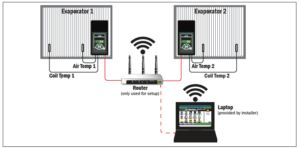
LAN or WAN
Local Area Network (LAN) is the proper terminology used for a network similar to Figure 4. When you are connected wirelessly to the evaporator controller and walk outside of the router range, the communication is disrupted. The evaporator controller is still managing the refrigeration system, but it is now impossible for the user to see the controller information.
Wide Area Network (WAN) is the terminology used for a network that covers very large areas geographically. The LAN used in Figure 4 can be connected to an existing customer network. Therefore, any access point at this network can allow you to communicate with the controller. For example, from a mechanical room in a high school you can remotely communicate with the cafeteria walk-in controller to monitor or modify parameters. In fact, when properly setup, you can communicate with the controller from anyplace that has Internet access.
For security matters, you must obtain the authorization from the customer IT personnel. Most likely a Virtual Private Network (VPN) will be created for your needs. Therefore, from your office you will have access to the controller with a password through the Web. Most of the end-users are already familiar with these simple procedures. Another simple option is to utilize the existing WI-FI, as many national restaurant chains already have a WIFI connection for their customers’ use.
Once the connection is established, all you need is the IP address of the controller.
Firmware and IP address
Each controller has an IP address (Internet Protocol) that allows for communication over networks. Like a letter in the mail, it requires the postal address to reach the final destination. Once the communication is made on the LAN or WAN, the IP address of the controller must be used in the browser window to access the application.
Figure 5 shows that instead of typing www.google.com we type the controller’s IP address. In this case 10.10.50.1.
Figure 5 – Controller IP Address
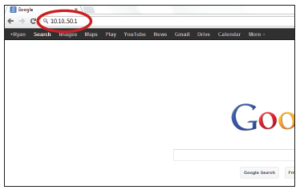
Press enter, and the webpage will appear. See Figure 6. Note that no software installation was required to access the controller. The web server is embedded in every controller.
Figure 6 – Controller application window
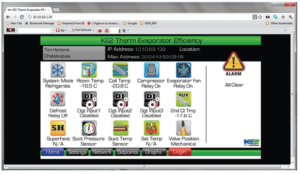
The Home page gives a quick glance of the refrigeration status mode and any alarms, if present.
From here we access performance graphs, under the Graphs button, which will help us diagnose the system. See Figures 7a and 7b.
Figure 7a – Week 1 Traditional Control
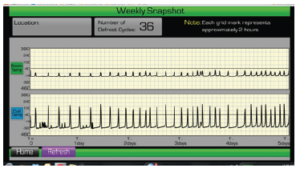
Figure 7b – Week 2
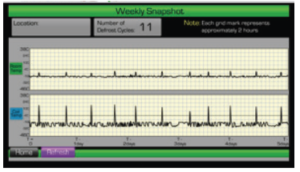
Figures 7a and 7b show the system status in week 1 before the intelligent controller is activated, and week 2 the first week after the controller begins managing the system.
In Figure 7a we can see the room temperature. From the right part of the graph we see that the room set point was impossible to maintain because of too many defrosts. There were 36 defrosts required in 5 days to manage the current load and reduce the frost on surfaces.
During the second week, using the new intelligent evaporator efficiency controller, most of the frost was eliminated, and the defrost cycles were down to 2 per day, for an average of 10-15 minutes, instead of 4 cycles of 45 minutes each. An 83% reduction of the defrost time!
Before, the average compressor run time was 17.6 hours, compared to 10.7 hours the second week. The evaporator frost sublimation and the proper demand defrost, maintain a high compressor suction pressure and reduces the compressor running time by 40%. As a bonus, the room set point is now achievable.
One week after the installation, we already notice some improvement. Figure 8 shows evidence. Without magic, the controller can defrost at the proper time and use sublimation of the frost on the evaporator to achieve energy savings.
A projection, based on a complete year, establishes that the system would save around $710 per year! (based on $0.10 kWh)
Figure 8 – Frost free surfaces
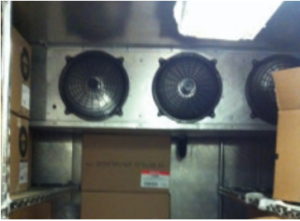
Conclusion
Restaurant chains, convenience stores, schools and other users are seeking cost effective solutions that will generate energy savings, and provide proper monitoring and operation of their refrigeration systems. Some owners are using this type of intelligent evaporator efficiency controller as a low cost solution to monitor room temperature remotely, when the store is closed.
This type of controller is becoming more prevalent in our industry. Air conditioning systems are already incorporating newer technologies including electric expansion valves, compressor and fan motor dc drives. It is only a matter of time that we will implement technologies in equipment designed to control temperatures lower than 45°F.
There are many energy consulting firms that are approaching end-users with solutions to control light power, temperature night set back thermostat and reduce outside air in ventilation systems. However, the major portion of the energy used in restaurant industries is coming from the refrigeration equipment. Studies show that up to 30-40% of the total energy goes into refrigeration.
Who is in a better position than refrigeration consultants and contractors to give advice to end-users? Competition will always seek opportunities. No doubt that the applications will increase in HVACR in the following years.
The service technician has no control on the product type, packaging, the height of the stockpiles that temporarily block the airflow of the evaporator fans, level of stock, door opening rate, and humidity level in most of the applications. When a service call is requested, an analysis of these variables is required to identify the cause of frosting of the evaporator and surfaces, it is normal that the first reaction is to increase the number of defrosts.
When many evaporators are installed, isn’t it more useful to see a global picture of the system instead of measuring temperature inside the cold space? Would you prefer to monitor a refrigeration system by Internet and save gas and time?
Finally, we now have technology that will provide more efficient system operation and at the same time act as an effective service tool. We can make optimal use of this technology. It is up to us to take advantage of it!

